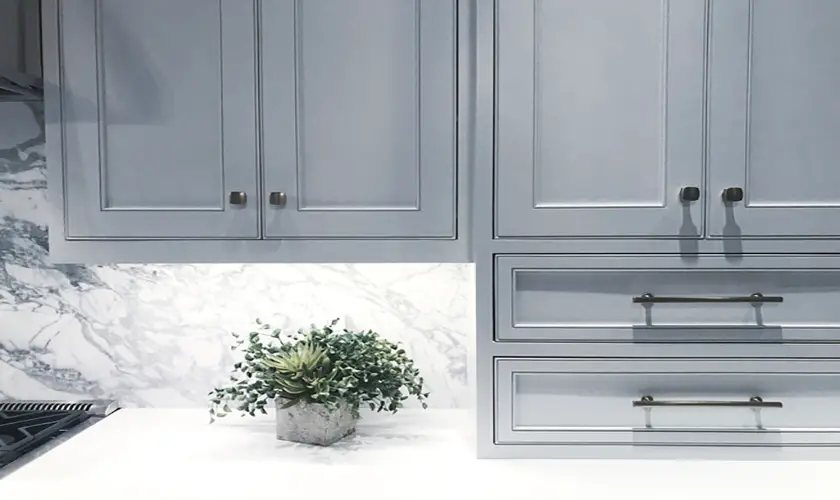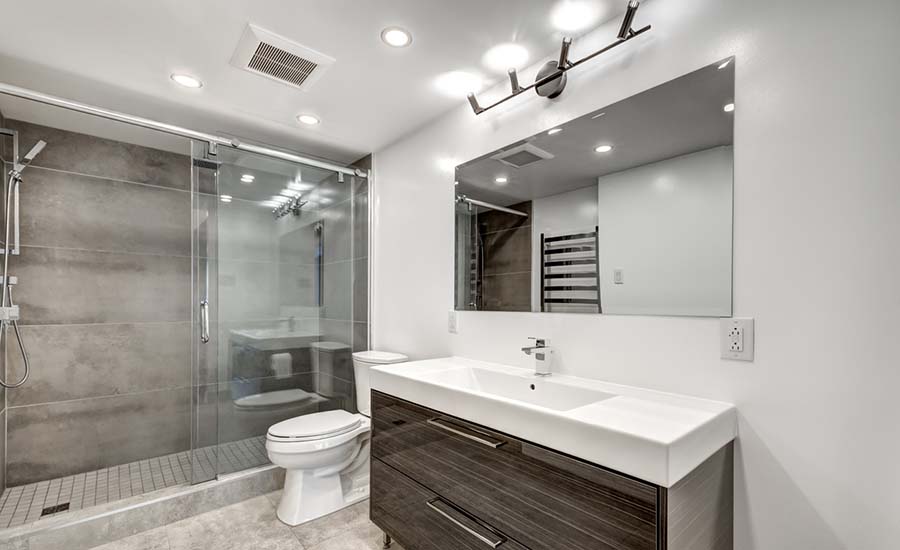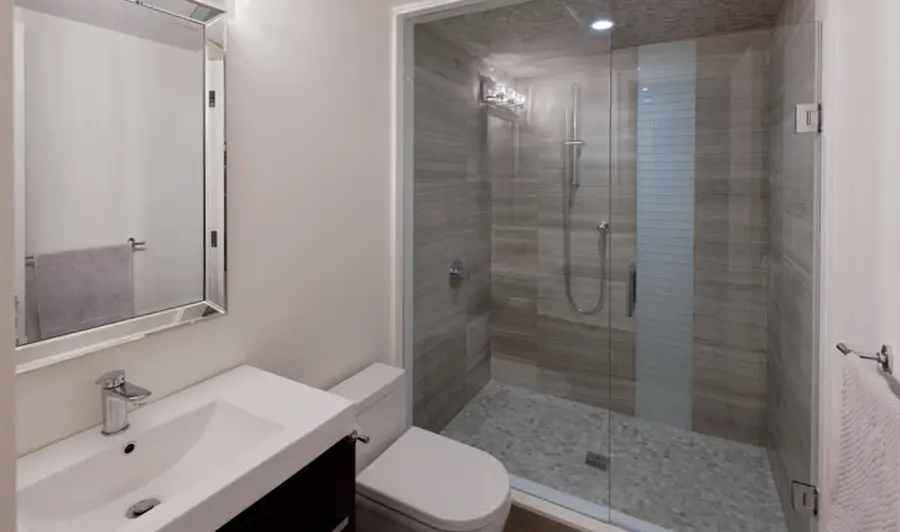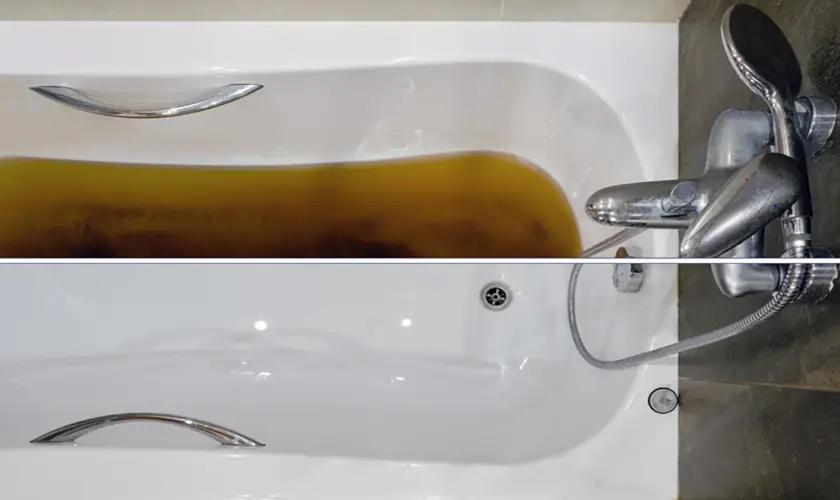
There are few things more disgusting and unsanitary than when you have standing water in your bathtub that won’t go away. Standing water is almost always the result of a clog in your drain lines or a damaged drain.
However, no matter what’s causing your bathtub drain to clog, there are a few ways to get rid of it, even if there’s standing water.
To unclog a bathtub drain with standing water, the first thing you’ll have to do is get rid of the water. Next, check for any visible blockages getting in the way of the drain. Finally, there are several methods you can use to unclog the drain for good and keep the problem from recurring. A toilet plunger, natural remedies, and chemicals are all possible solutions.
In this article, we’ll explore seven ways that you can use to get rid of bathtub clogs and possibly prevent them in the future. Each of the ways we look at can get performed by people without plumbing experience. We’ll also discuss when to stop trying to save money and call a professional plumber.
What Causes Clogs in Your Bathtub Drain?
Drain clogs, no matter where they happen, are inconvenient. However, a clogged bathtub drain can ruin your entire day and change your schedule. For that reason, it’s important to know what causes clogs in your bathroom to prevent them from ever happening.

Hair
The most common cause of clogs in your bathtub is hair goes down the drain. Modern plumbing pipes are better at getting rid of lost hair during your showers or baths, but it’s still not ideal. Old plumbing systems, in particular, are prone to hairballs mucking up the system. Either way, however, it’s wise to have special hair catchers in your bathtub drain to avoid having to worry about hair clogs getting stuck inside the drains.
Soap Scum
Most people don’t realize that the soap they’re using is another common cause of clogs. Soap scum is the by-product of the soapy suds and bubbles left behind after you get out of the shower. If enough of it can pile up in your drains, it will cause a clog.
Foreign Objects
Foreign objects such as toys and feminine hygiene products aren’t as big a problem with bathtubs as with toilets. There’s a protective drain cover atop the drain that prevents large objects from falling inside of it. However, it still happens from time to time on old tubs and showers that don’t have a drain cover.
Mineral Deposits
If you have hard water in your home and no water softener, you’re in for unfortunate drain clogs. Hard water contains minerals such as iron, calcium, and magnesium that pile up when they have enough presence in your water. Depending on where you live, you’re more at risk for mineral deposits clogging your drain pipes than other people are. It may be necessary to have your water tested so you know if you need a water softener or not.
Old Pipes
Finally, it could simply be that you have an old plumbing system with old pipes. Historically, residential plumbing systems would get installed using cast iron pipes for the drain lines. Unfortunately, these metal pipes break down from the inside and start to snag hair and other objects that fall into the drain.
It’s also possible for the pipe to break down and create a clog in the drain line. Either way, you can choose to temporarily unclog the drain with one of the following methods or install an entirely new plumbing system.
How to Unclog a Bathtub Drain With Standing Water
Now that you know what’s causing your clogged drain, let’s dive into a few ways to remedy the problem.
Check for Visible Blockages
When you have a drainage issue, the first thing you’ll want to do is check for visible blockages on top of the drain. It may be that you simply left a washrag or towel on top of the drain, and it’s preventing water from going down. It’s also possible that you’ll see visible chunks of hair on top of the drain, which usually means that there’s more below.
However, if you don’t see any visible obstacles preventing drainage, you’ll have to dig deeper into what’s going on.
Try the Natural Method
Before you go and start using harsh chemicals on your bathtub drain, you should first try using natural drain cleaners. A natural remedy is always the best option when it works. Here are a few naturals to try.
- First, you’ll have to remove any standing water in the bathtub using a wet vac or a sponge and bucket.
- With the water out of the way, you’re ready to begin.
- Take one cup of baking soda and pour it down the drain. Use a funnel if necessary to make sure it all goes in.
- Next, pour half a cup of vinegar after the baking soda, preferably white and distilled.
- You should hear some buzzing as the vinegar and baking soda do their work.
- Once you hear the buzzing or fizzing start, take a plunger or a bucket and form an airtight cover on top of the drain. Leave the cover on until you hear the fizzing stop.
- Wait for a half-hour after the fizzing has stopped, pour a gallon of hot water or boiling water down the drain.
- If the water drains down the drain, you have fixed your clog!
If that concoction doesn’t work, here’s another natural remedy that you can try. Follow the same steps as above, but instead of using a cup of white vinegar, you will use salt. So, in the step where you pour half a cup of vinegar down the drain, you’ll mix half a cup of baking soda with half a cup of salt and warm water. Pour the new concoction down the drain and follow it up with a gallon of hot water.
Remember, natural mixtures like the ones we just looked at are the best way and the easiest way to get rid of clogs. Please note that you should always wear rubber gloves when working with chemicals or standing water as it’s very unsanitary.
Use a Chemical Drain Cleaner
Chemical cleaners for your drain should only be used as a last resort when nothing else is working. However, when the time comes to turn to Drano or a similar product, here’s what you need to know.
- Start by checking the drain for visible blockages and obstacles.
- If none are present, try all the other options on this list, such as a natural solution, a plunger, etc.
- However, if nothing else works, you should go to your local hardware store and purchase some Drano.
- Drano will undo your bathroom drain clog without damaging the pipes inside.
- Follow the instructions on your container of Drano to a T, and the Drano product should fix your problem.

Implement a Drain Snake
A plumbing snake is an excellent option when liquid concoctions aren’t doing the trick and you don’t want to proceed to harsh chemicals. Drain snakes work by reaching into the drain itself and physically pulling out hair and other things causing clogs. It’s equipped with a crooked head or drain claw that slips around an object and pulls it out when you tug on its attached line.
I recommend this drain snake from Amazon because you can use it with a drill or without.
- Start by removing the drain cover that’s keeping things from entering your drain.
- Next, take your plumber’s snake and stick it into the drain.
- You can also insert the snake through the overflow tube above the drain if desired. Entering through the overflow drain might be better if you’re inexperienced with a plumber’s snake because you could potentially break your drain pipe trying to push the snake through.
- Either way, you’ll push the snake manually or use the attached handle to propel the auger forward.
- Anytime you feel the snake meet opposition and start to bend or kink, gently pull it back a few inches and try moving forward again.
- Push the snake inward until you’re satisfied that you’ve gone far enough.
- Most clogs will be within the first 10 feet from the start of the drain, so don’t bother going much further than that.
- Slowly retrieve the snake by pulling or reeling it out.
- If everything went according to plan, the claw of the snake should come out with hair or whatever else was causing the clog attached to it.
Remove the Drain Stopper
While it’s rare, your bathtub stopper or drain stopper may be permanently stuck in the closed position. A stuck stopper can happen on older tubs or ones that aren’t well maintained. Essentially, the mechanism that opens and closes the drain stopper becomes disconnected from the actual stopper.
If the mechanism became disconnected when the stopper was closed, it would remain in that position until you manually alter it. The only way to do this is by removing the stopper completely and either fixing it or installing a new one.
Toilet Plunger
Using a toilet plunger is one of the few times you won’t have to remove standing water from within the bathtub. You’ll use a plunger much the same way you would with a toilet, by placing it over the drain and pushing it in and out to create suction. Here’s how it works.
- If you want to, you can remove all the standing water in your tub, but this isn’t mandatory with a plunger.
- Next, take a rag and plug the overflow tube above your drain. If you don’t do this, you won’t be able to create suction with the plunger.
- Take your toilet plunger and place it directly on top of the drain.
- The plunger will form an airtight seal around the drain on its own, but you should apply some pressure to ensure this happens.
- Start plunging with slow and gentle pushes, and remove the plunger to see if it worked.
- If water still doesn’t go down the drain, try plunging again but more forcefully this time.
- Continue doing this for several tries, as some clogs are deep and stubborn and take time to work out.
- Once the water starts draining, turn on the water tap and allow running water to go down the drain for five to ten minutes to ensure that it’s completely unclogged.
Dump Hot Water Into the Drain
I included this option as the last one on the list because it probably won’t work. However, if you don’t have household items like vinegar, baking soda, and salt at your disposal, you can try hot water by itself. The odds of this working aren’t great, but it’s a good last resort before calling a plumber or turning to chemicals.
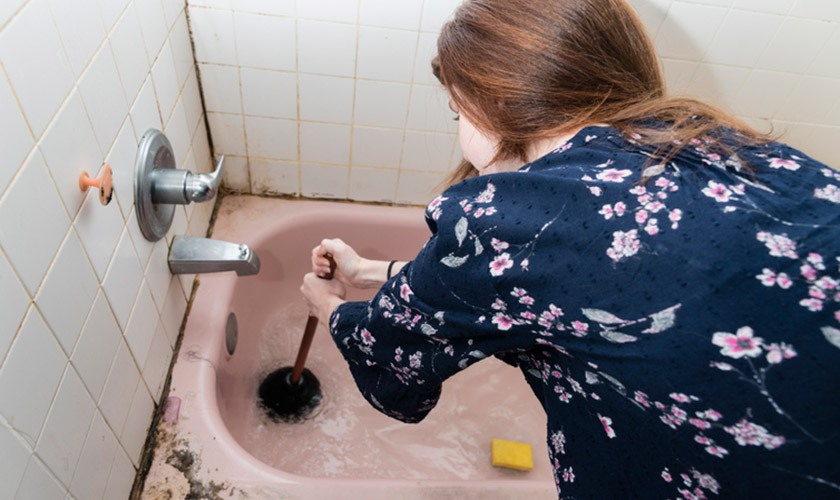
What to Do If Nothing Works?
If you’re at your wit’s end and nothing you try works, you’ll have to call a plumber and have them unclog your drain for you. A clogged bathtub drain with standing water isn’t just inconvenient. It’s also potentially dangerous. The longer that water is present, the more likely mold, mildew, and other nasty problems will set in.
Calling a plumber isn’t the cheapest option, but it’s necessary as a last resort. However, a plumber can diagnose if a bigger problem exists, like tree roots blocking the main drain system from the house to the street or septic system.
Related Questions
How to get water out of a bathtub that won’t drain?
To start the unclogging process, you’ll first have to get standing water out of your bathtub. You can use a wet vac and sweep it out or use a sponge or cup and pour water into a bucket or your toilet.
Can you put Drano in a tub with standing water?
Most chemical agents require you to remove standing water before applying them to clogs. However, there are certain types of Drano that you can pour into standing water, and it will make its way through the water and into the drain. Make sure to check your container of Drano before buying it to make sure it has this capability because not all of them do.
Why is there standing water in my tub drain?
If there’s standing water in your tub drain and the stopper is open, you have a clogged drain. Hair is usually the culprit of a clogged bathtub drain.
Final Thoughts
While clogged drains are a major inconvenience and problematic, there are many ways to remedy the problem. You should always start with natural solutions such as plunging or vinegar and baking soda mixtures. If those don’t work, proceed to more intrusive methods like an auger, drain snake, or chemical agents. Finally, contact your local plumber and have them fix your drain pipe if all else fails.



